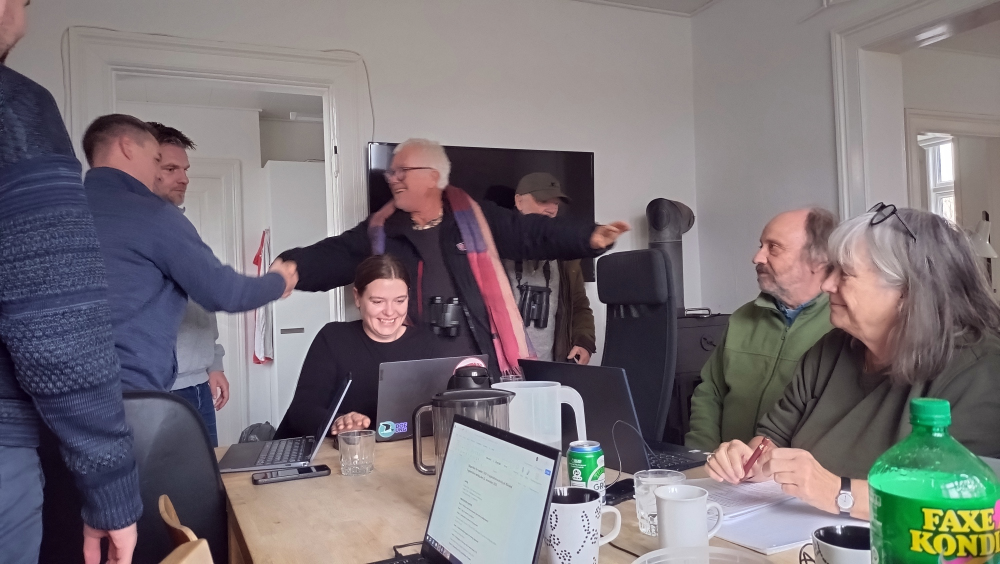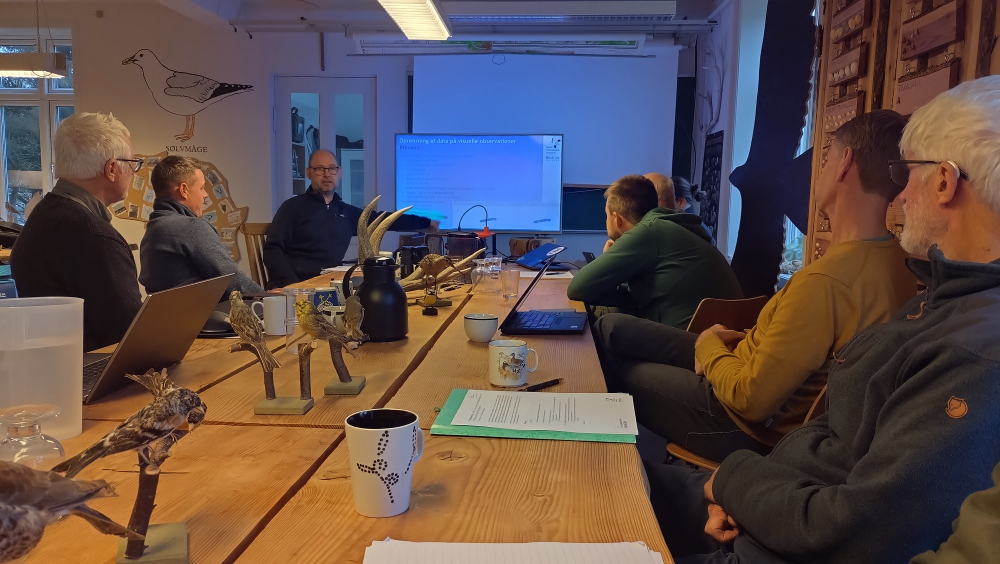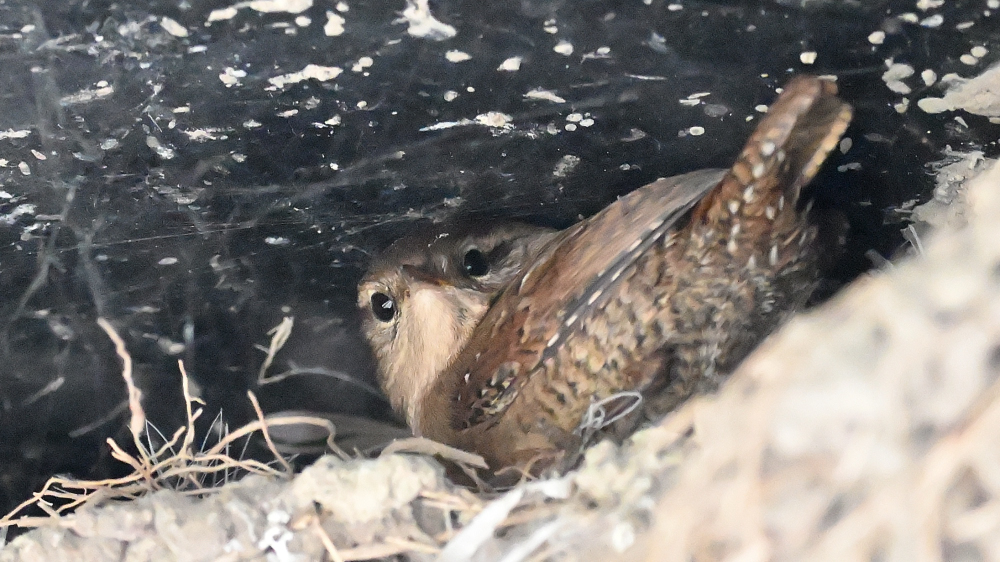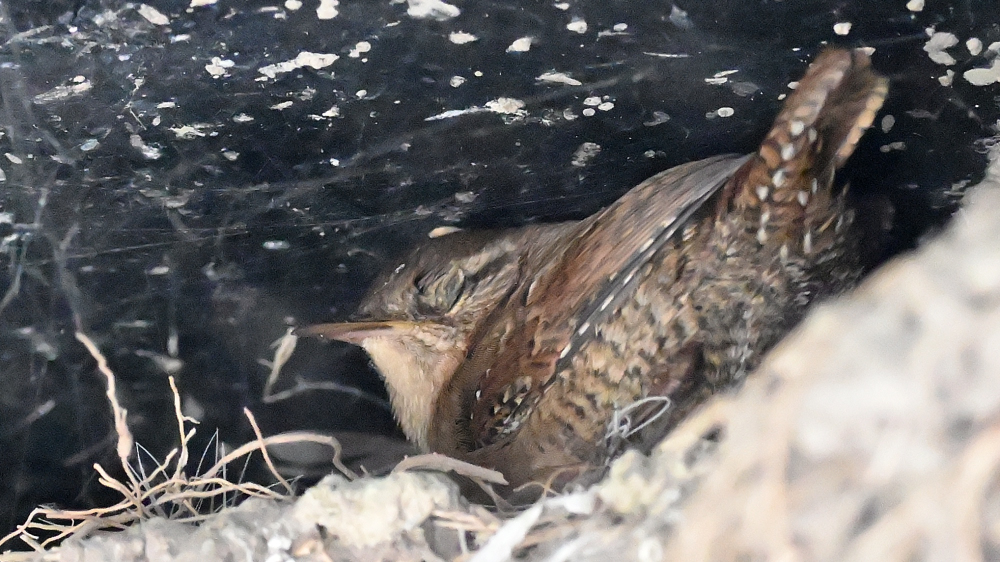Gedser Fuglestation Blog
Her på Gedser Fuglestations blog bringes korte nyheder i dagbogsformat om hændelser på fuglestationen.
Begrænset træk i dis og småregn
Trækket på Odden: Diset vejr med småregn begrænsede sigtbarheden, og der var givet fugle, som fløj for langt ude til at være synlige for os. Der er efterhånden mange rastende fugle på vandet, hvor de flyver op, når der kommer en lodsbåd, og er med til at gøre det vanskeligt at se, hvilke fugle, der trækker forbi Odden, og hvilke der flytter sig lidt af og til, men ellers er stationære i områdete. Det er en del af udfordringen.
Vi var to fra fuglestationen til at observere og tælle. Mest bemærkelsesværdige var for os et stort antal Viber (Vanellus vanellus), som rastede og fouragerede på pløjemarker. På et tidligt tidspunkt var 230 af dem ude over vandet i trækforsøg i tre flokke, men de fleste vendte tilbage til markerne. Vi talte kun 23, som forsvandt mod sydvest over havet. På samme måde havde vi et halvt hundrede Hjejler (Pluvialis apricaria) ude at vende, men ellers stående helt stille på pløjemarken, hvor de faldt godt i med omgivelserne.

Trods den begrænsede sigtbarhed fik vi blandt andet noteret et halvt hundrede Rødstrubede Lommer (Gavia stellata) og en enkelt Sortstrubet (Gavia arctica) samt 90 Toppede Skalleslugere (Mergus merganser), mens der ikke kom nogen udtrækkende små- eller rovfugle fra land. Det sidste par timer var den næsten ingen aktivitet at se over havet - bortset fra opskræmte rastefugle.
I alt blev det til 736 fugle på træk fordelt på 23 arter.
Se dagens observationer fra Gedser Odde i DOFbasen.
Folk på stationen: Henrik Jørgensen, Ole Friis Larsen
Flere arter i hård vind fra syd
Trækket på Odden: En kold og temmelig blæsende morgen gjorde det lidt vanskeligt at finde læ for den meget sydlige vind, men det lykkedes tæt på en af murene på den gamle marinestation. Halvdelen af dagens fugletræk foregik i den første time omkring solopgang med 1.300; i den næste time faldt det til 700 fugle, og så var der 700 de næste to timer og stort set ikke nogen i den sidste time. Det var i sig selv en interessant oplevelse.
Selv om himmelen ind imellem forekom blå, var der hele formiddagen en dis, som gav en kort sigtbarhed over vandet, og måske var der et usynligt træk af Ederfugle (Somateria molissima) ude i disen, så det ’kun’ blev til lidt over 1.100 af dem – en tredjedel af, hvad der kom dagen før.
Mest bemærkelsesværdigt var imidlertid nok et lavt træk af lommer, men til gengæld et betydeligt større ryk af Toppede Skalleslugere (Mergus merganser) med 212 mod 68 dagen før. På samme måde med 131 Gråænder (Anas platyrhynchos) mod 53 dagen før. Der kan være stor variation i trækket fra dag til dag i samme periode, og selv om antallet af fugle var betydeligt lavere end onsdag, var der flere arter.
I alt blev det til 2.726 fugle på træk fordelt på 38 arter.
Se dagens observationer fra Gedser Odde i DOFbasen.
Folk på stationen: Ole Friis Larsen
Sorte ænder på kanten af tågen
Trækket på Odden: Vinden fra nord var svag og føltes kun som en kold træk, så den havde næppe nogen stor indflydelse på dagens træk, og hvor der var læ føltes det ligefrem mildt at være, selvom dagen startede på lidt over en grads varme og aldrig nåede over fem grader. Til gengæld var der lukket effektivt for solen af en gråt skylag, og i mere end halvdelen af observationstiden var der tågedis og sigtbarhed helt ned til nogle få hundrede meter.
Ikke desto mindre var der fugletræk over havet, hvor dagens gæst, Orla Jacobsen, som var med det meste af tiden, især pegede på Sortænderne (Melanitta nigra). De kom ikke i nær så stort antal som Ederfuglene (Somateria molissima), men rollerne var byttet om, og trækket forskelligt. Ederfuglene kom kun ad ruten langt ude østfra som lyse og mørke prikker i store flokke i et massivt træk det første par timer, hvorefter det træk stilnede hastigt af.
Sortænderne kom i mindre flokke nordfra, meget tættere på Odden, men stadig på kanten af tågen, og de fortsatte gennem helt perioden, så det gav god mening at sige, at lidt over 900 Sortænder fyldte mere i dagens træk end de lidt over 3.000 Ederfugle. Bemærkelsesværdigt var også et træk af lige under 200 Fløjlsænder (Melanitta fusca), som også kom tættere forbi i mindre flokke spredt ud over alle fem timers tælling.
Trækket af lommer, som dagen før nåede op i næsten fem hundrede, var imidlertid sat på pause med bare lidt over hundrede fugle.
Fra land kom der kun et par håndfulde småfugle ud over havet, en Spurvehøg (Accipiter nisus), en Fjeldvåge (Buteo lagopus) og syv Røde Glenter (Milvus milvus).
I alt blev det til 4.652 fugle på træk fordelt på 32 arter, og det var ikke så ringe endda.
Se dagens observationer fra Gedser Odde i DOFbasen.
Folk på stationen: Ole Friis Larsen
Der kommer Lommer!
Trækket på Gedser Odde:
Efter gårsdagens vintervejr var det igen blevet efterår. Vinden var aftaget noget og drejet mod SØ, og vi fandt god læ ved buskene nær sydspidsen. Flemming Pagh Jensen havde tilbudt at træde til i Oles fravær, så vi var to på obsen hele formiddagen. Det viste sig hurtigt at være en stor fordel, for det blev en af de dage, hvor der kom en jævn strøm af fugle det meste af tiden. Dejligt at vi kunne supplere hinanden, tak til Flemming for det!
Der foregår stadig et træk af andefugle, men for de fleste arter er antallet noget lavere end tidligere på sæsonen. I går skrev jeg om et træk af Ederfugle (Somateria molissima) langt fra kysten, som jeg først kunne se, da det på et tidspunkt klarede op. I dag kunne vi følge dette træk hele formiddagen, og det blev dagens største tal, med lige over halvdelen af dagens 5050 fugle. Der trak også Ederfugle nærmere land, og denne art udgjorde godt og vel 2/3 af dagens totale antal.
Alligevel var det en anden art, som kom til at fylde i billedet. For første gang dette efterår kom der rigtigt gang i Lommerne, og inden vi sluttede havde vi noteret 484 Rødstrubet Lom (Gavia stellata) og 10 Sortstrubet Lom (Gavia arctica). Det er helt normalt, at fordelingen mellem de to arter er sådan. En del af Lommerne kom nærmest lige over hovederne på os, om end så højt at vi flere gange først opdagede dem, når vi hørte deres kald. Det virkede som om de kom ud af de ganske lavthængende skyer for så flere gange at forsvinde ind i den næste sky igen.
Selv om sigtbarheden var betydeligt bedre end i går, var der kun ganske få småfugle, som trak ud. Vi så heller ingen trækkende rovfugle, kun den lokale Tårnfalk (Falco tinnunculus) var forbi nogle gange på sin fouragerings-runde.
Vejrudsigten varsler regn i nat og vinddrejning til nord, så måske bliver det en helt anden omgang i morgen. Det får tiden vise!
En af dagens 484 Rødstrubet Lom. (Foto Mads Elley)
Udbytterig weekend på Gedser Odde og Blåvand Fuglestation
Trækket på Odden: Efter en weekend med pæne træktal, var det lidt af en omvæltning at vågne op til sne, og forventningerne til dagens observation var heller ikke store. Fra obsens begyndelse var der sne i luften og dårlig sigt på ned til nogle få hundrede meter, og først omkring klokken 10 kom der en vis opklaring. Derfor kunne jeg med stor sandsynlighed ikke se en væsentlig del af trækket, hvilket blev tydeligt da jeg endelig kunne se et par kilometer ud, og kunne konstatere et jævnt træk af Ederfugl (Somateria molissima) og Rødstrubet Lom (Gavia stellata). Af andre årsager måtte jeg nøjes med tre timers obs i dag, hvorfor dagens totaler er lavere end de nok burde være.
Trækket var stort set udelukkende over vandet, og overraskende mange Gråænder (Anas platyrhynchos), som kom i flokke på op til 32 individer. Vi ser kun få Gråænder tidligere i sæsonen, men her i november foregår der et reelt træk også af denne art.
Jeg registrerede ingen rovfugle og heller ingen småfugle, som havde mod på at krydse Østersøen i dag, men karakteristisk nok kom et par mindre flokke af Viber (Vanellus vanellus) på dagen med den første sne på Sydfalster. Jeg så i alt 22 individer, men der var mange flere i baglandet. Måske en del af dem er trukket ud i løbet af dagen, ellers kommer der nok flere i morgen.
Forholdene taget i betragtning var det overraskende at dagen alligevel bød på lidt over 1000 individer på blot tre timer.
I morgen er der igen fuld obs-tid på hele Nordens sydligste punkt.
Nyt på stationen: Vores franske ringmærker Théophile Fontaine har været her siden slutningen af september, og nu er det tid til at vende hjemad for ham. De seneste dage efter ringmærkningen sluttede, har Théophile været aktiv som observatør. Vi har været meget glade for hans besøg og ønsker ham alt godt fremover.

Sådan så det meste af formiddagen ud, sne og ringe sigtbarhed. Her flyver en Skarv forbi Gedser Odde.
Nyt fra stationen: Flere folk fra Gedser Fuglestation deltog i weekenden i to møder på Blåvand Fuglestation, hvor der også kom kolleger fra Skagen Fuglestation og udvalg i DOF/BirdLife Danmark. Det første møde blev holdt lørdag og søndag morgen i DOF’s Fuglestationsudvalg. Udvalget er det forum, hvor repræsentanter for de tre såkaldte A-stationer diskuterer fælles udfordringer, holdninger og initiativer indbyrdes og med repræsentanter for DOF’s videnskabelige udvalg, feltudvalget og DOF Ung.
De tre fuglestationer på Danmarks sydligste (Gedser Odde), vestligste (Blåvands Huk) og nordligste (Grenen, Skagen) punkter arbejder stadig tættere sammen om mange forhold og har blandt andet nu en fælles ansøgningsadresse og procedure for især unge ansøgere til et ophold på en fuglestation, og mange af opholdene foregår som forløb, hvor de unge kommer på flere af stationerne for at lære ringmærkning, træktælling og formidling.

Den slags møder er selvfølgelig også hyggelige sociale begivenheder, hvor fuglestationernes frivillige ser hinanden og udveksler erfaringer.

Efter selve fuglestationsudvalgsmødet var der resten af søndag formiddag og om eftermiddagen et projektseminar om at ”Videreudvikle omkostningseffektive metoder til standardiseret bestandsovervågning af trækfugle ved brug af Citizen Science”, altså om kvaliteten af de data, som fuglestationerne indsamler ved ringmærkningen og træktællingen. Her var det Timme Nygaard fra Fuglenes Hus i DOF og Amanda Johannisson fra Ringmærkningsadministrationen ved Statens Naturhistoriske Museum i København, der præsenterede analyser af vores data, som heldigvis har vist sig at have en meget høj kvalitet.
Med til seminaret var også Anders Tøttrup fra Statens Naturhistoriske Museum, hvor han er specialiseret i studier af trækfugle og er Danmarks første professor i citizen science, som netop er, hvad vi laver og træner folk i på fuglestationerne.

Det er selvsagt vigtigt for os, der indsamler og leverer data, at materialet er godt og anvendeligt for de mennesker, der skal bruge vores data til blandt andet at skrive videnskabelige artikler. På seminaret diskuterede vi også forbedringer af de databaser, som vi bruger, blandt andet muligheden for at angive antallet af træktællere i DOFbasen, fordi det har betydning for hver enkelt træktællings resultater, om der har været en, to, tre eller aktive flere observatører i felten.
En anden forbedring af kvaliteten kan blive, at hver fuglestation får et antal arter, som de skal have et særligt fokus på at registrere – det kunne for eksempel være Toppet Skallesluger (Mergus merganser) ved Gedser Odde. Her er vi mest optaget af at registrere almindelige fugle, som kommer i så store antal, at vi synes, de er velegnede til at lave statistikker over, men analysearbejdet i det fælles projekt for DOF og Ringmærkningsadministrationen har vist, at også vores registreringer af mindre almindelige og sjældne fugle ved de tre fuglestationer har så høj kvalitet, at også den slags arter kan gøres til fokusarter.
Folk på job for stationen i weekenden: Théophile Fontaine, Mads Elley, Hans Lind, Louis A. Hansen, Anne Marie Reith, Ole Friis Larsen
Eiders, Divers, Coffee and nice company
Trækket på Odden: There won't be a poem today. It was my last morning as a migration counter here in Gedser. Tomorrow, I will pack up and head back to France. But what a last morning outside at the tip ! I won't mention the cold (but it was very cold — just ask Mads!). It started really well with lots of Eiders. It had been many days since we had seen numbers like today's: 737 birds in total.
The migration of divers was also quite nice, with the numbers increasing gradually. We saw 211 Red-throated divers and 19 Black-throated divers, which is a good number for this species. Many of them were migrating far out, but we also saw flocks flying over the tip, which was great because we could hear the flight calls of the Red-throated divers.
Here is one of the divers who flew close enought for a picture. A Black-throated diver, bigger bill, long legs, more wight behind the wings. Foto : Théophile Fontaine
We also saw a White-tailed eagle fishing over the sea, quite far away at first, and then getting closer. At one point it was attacked by a Herring gull. I would have been very happy to show you a nice picture of this, but unfortunately, the picture is completely blurry. Nevertheless, you can see in this picture that the gull doesn't seem very happy about the white-tailed eagle's presence.
Herring gull and Whight-tailed eagle, not the perfect couple... Foto : Théophile Fontaine

Folk på stationen: Mads Elley, Louis A. Hansen, Théophile Fontaine
November rose
Trækket på Odden: Louis, Mads and I braved the cold at the tip this morning. But it was another lovely morning, with just more than two thousand birds !
Compared to previous days, the migration of Havlits (Long-tailed ducks) and Fløjlsand (Velvet scoters) was impressive, with 86 and 126 birds respectively. This morning was especially good for the Sortand (Black scoters) and the Stormmåge (Common gulls), with 431 and 347 birds respectively, which is a third of all the birds this morning.
As in previous days, I was very happy to see Lom (Divers) and Lille Skallesluger (Smews)! This morning, we saw three males, the first of the season, and this is also the highest number of this species seen this year: six...!
Unfortunately, the light was terrible for pictures; the birds were flying far away.
But :
Outside at the tip for one purpose:
Looking for nice birds – flamingos?
It's cold, and the wind is terrible for the nose.
Two thousand and two birds, and the November rose.
November rose. Foto : Théophile Fontaine
Folk på stationen: Mads Elley, Louis A. Hansen, Théophile Fontaine
When the sun is our saviour
Trækket på Odden: The pond was partially frozen this morning, which was good indicator of how much it will freeze at the tip... It started slowly in the first hour, with mostly (Common scoters), (Red-breasted mergansers) and Stor skallesluger (Red-throated divers). After two hours, we had seen around 400 birds, which is not a huge number, but still more than in the five hours of yesterday.
It's amazing to see such large numbers of Divers migrating, as well as a few Lille skallesluger (Smew). We have these species in France, but they are wintering. But I must say that to see a Smew in migration, you have to earn it ! It was cold, cold, cold !
Note the nice number of geese this morning, with three species: Barnacle, Greylag and Bean Geese. We saw 67 of the last one, the subspecies Anser fabalis rossicus, all in the last hour.
The short neck is one of the main criteria used to distinguish subspecies tundra from taiga, Seadgås (Tundra bean geese) Foto : Théophile Fontaine
We were surprised to see gulls everywhere over the sea, mostly herring, common and black-headed gulls. Several of them were probably attracted by all the ploughed fields in the area over the past few days.
We finished the morning having seen a little over 900 birds from 39 species, which is not bad ! There were more than 100 Rødstrubet lom (Red-throated diver), three Sule (Gannets) and an hour of full sunshine! (which was perhaps the best thing about the day).

The ringing: The weather this afternoon was really nice with some sunshine and no wind, so I decided to try one last time for the Gråsisken (redpolls), Grønsisken (siskins), Silkehale (waxwings) and Lille Korsnæb (crossbills). It didn't work particularly well, but the number of species wasn't too bad given the low number of birds! Eleven birds from seven species, including one beautiful adult male siskin and a nice young female brambling.
Grønsisken (siskin) Foto : Théophile Fontaine

Folk på stationen: Théophile Fontaine, Ole Friis Larsen
En smule ringmærkning, lidt træktælling og tid til en lur
The ringing: The low breeze this morning, without rain, gave me the chance to try some ringing. I opened a few nets and put sounds of Grønsisken (Siskin), Gråsisken (Redpoll), Lille Kornaeb (Crossbill) and Silkehale (Waxwing). Although the nets were pretty empty, I saw some birds eating in the hawthorn: Dompap (Bullfinch), Solsort (Blackbird) and Sjagger (Fieldfare).
The speakers worked, but only briefly: five Lille Gråsisken (Acanthis flammea cabaret) at 10:30. One waxwing spent a few minutes in the garden. I saw it arrive from the east, perch at the top of a tree, and then fly away to Gedser.
The surprise of this morning was a young male Stor flagspaette (Great spotted woodpecker), the last one was more than a month ago!

The nets will remain closed tomorrow. I will join Ole again at the tip before he leaves for Blåvand.

Trækket på Odden: Formentlig var det vinden fra nord, der gjorde forskellen. I hvert fald var der ikke meget træk at observere onsdag morgen og formiddag. Der var bølger med dis over havet, og så var der kun en enkelt observatør; det betyder også noget, men ikke så meget …
I alt blev det til 299 fugle på træk fordelt på 28 arter.
Det var over hele linjen, at fuglene udeblev fra trækket. Dagens mest talrige art blev Sortænderne (Melanitta nigra) med 66 individer, fulgt af 25 Ederfugle (Somateria mollissima).
Der var ellers optræk til et fint træk af Rødstrubede Lommer (Gavia stellata) med 17 fugle ret hurtigt efter hinanden og på samme måde med 13 Dværgmåger (Hydrocoloeus minutus), men det ebbede hurtigt ud for begge arter.
Det gav bedre tid til at kigge trækkende og lokale måger efter i sømmene, og det var sjovt, selv om det ikke kastede noget særligt af sig.
Når vinden er hård, kulden bider, eller regnen siler ned, er Danmarks sydligste bygning, den gamle marinestation, en sikker havn for såvel fuglestationens observatører som småfugle, der kan lede efter insekter i vindfanget i ly for elementerne. Denne dag så det ud til, at en Gærdesmutte (Troglodytes troglodytes) ligefrem er flyttet ind i en af de svalereder, der er tomme, mens svalerne er i Afrika for at tilbringe vinteren der. Her er en lille oplevelse:



Se dagens observationer fra Gedser Odde i DOFbasen.
Folk på stationen: Théophile Fontaine, Ole Friis Larsen
Vidunderligt gråvejr
Trækket på Odden: Gråvejr kan sagtens være rigtig godt vejr, når det gælder fugletræk over havet. Onsdag var vi begge af sted fra fuglestationen og slap næsten for regn, men ikke for alle nuancer af gråt, som Theophile så smukt formulerede det. Vinden drejede i løbet af morgenen fra sydvest til syd og fjernede dermed næsten alle muligheder for læ, men netop et spændende træk holdt humøret oppe gennem alle fem timer.

Med 589 Krikænder (Anas crecca) så vi det fjerdestørste antal i år på en enkelt standarddag. Mere bemærkelsesværdigt var det, at det var det suverænt største antal på en novemberdag i de år, vi har gennemført systematiske træktællinger for Gedser Fuglestation. Næststørste antal er 188, som kom 13. november 2021. Trækket af Krikænder har i det hele taget været fint i dette efterår med 9.335 indtil nu i forhold til et efterårsgennemsnit på 6.984. Dagens største samlede flok af de små svømmeænder var tilmed imponerende med 86 fugle.

Flere andre arter var med til at gøre dagens to observatører glade. Vi talte 131 lommer, hvoraf 33 var Sortstrubede Lommer (Gavia arctica). Det høje antal af den art udspringer måske af, at vores kolleger ved Põõsaspea neem i Estland for ti dage siden talte 272 Sortstrubede Lommer på vej mod sydvest, hvilket også var usædvanligt for dem. Den dag talte de desuden blandt andet 69 Små Skalleslugere (Mergellus albellus), hvilket måske også er forklaringen på de fem hunfarvede fugle, som vi onsdag formiddag talte af den art i trækket forbi Gedser Odde.

Læg dertil et i øvrigt smukt træk af svømmeænder med 72 Knarænder (Mareca strepera), Gråænder (Anas platyrhynchos) og Pibeænder (Mareca penelope) blandet op med lidt Spidsænder (Anas acuta) og Skeænder (Spatula clypaeta), og vi kunne ikke have forlangt det meget bedre på sådan en rigtig kold og grå novemberdag.

Tirsdag lå der en død Trane (Grus grus) på stranden, onsdag var den skyllet væk, men den mindede om en af de farer, som fugle møder på trækket. Tranerne er taget af sted i små familiegrupper, som har samlet sig til store flokke på rastepladser, hvor de har mødt den dødbringende fugleinfluenza H5N1 og er døde i tusindvis. Der kommer uden tvivl mærkbart færre tilbage i foråret for at yngle. Siden de første døde fugle blev fundet 3. oktober ved Galenbecker See, er der indsamlet 15.500 døde Traner i Tyskland. Efter at en stor del af bestanden er trukket videre mod overvintringspladser i Spanien, er der fundet 10.000 døde Traner i Frankrig og ’hundredvis’ i Spanien.
Organisationen Kranichschutz Deutschland anslår, at der ud over de indsamlede døde Traner er et stort ’mørketal’ af omkomne fugle, som ikke er fundet.
Det er ikke kun vores Traner, der bliver ofre for viruset H5N1. I USA er der i en enkelt delstat fundet 1.500 døde Prærietraner (Antigone canadensis) og værst af alt en Trompetertrane (Grus americana). Dem er der i forvejen kun 830 af, og fugleinfluenza blandt dem er selvfølgelig en meget alvorlig trussel mod hele bestanden.
Se dagens observationer fra Gedser Odde i DOFbasen.
Folk på stationen: Théophile Fontaine, Ole Friis Larsen









